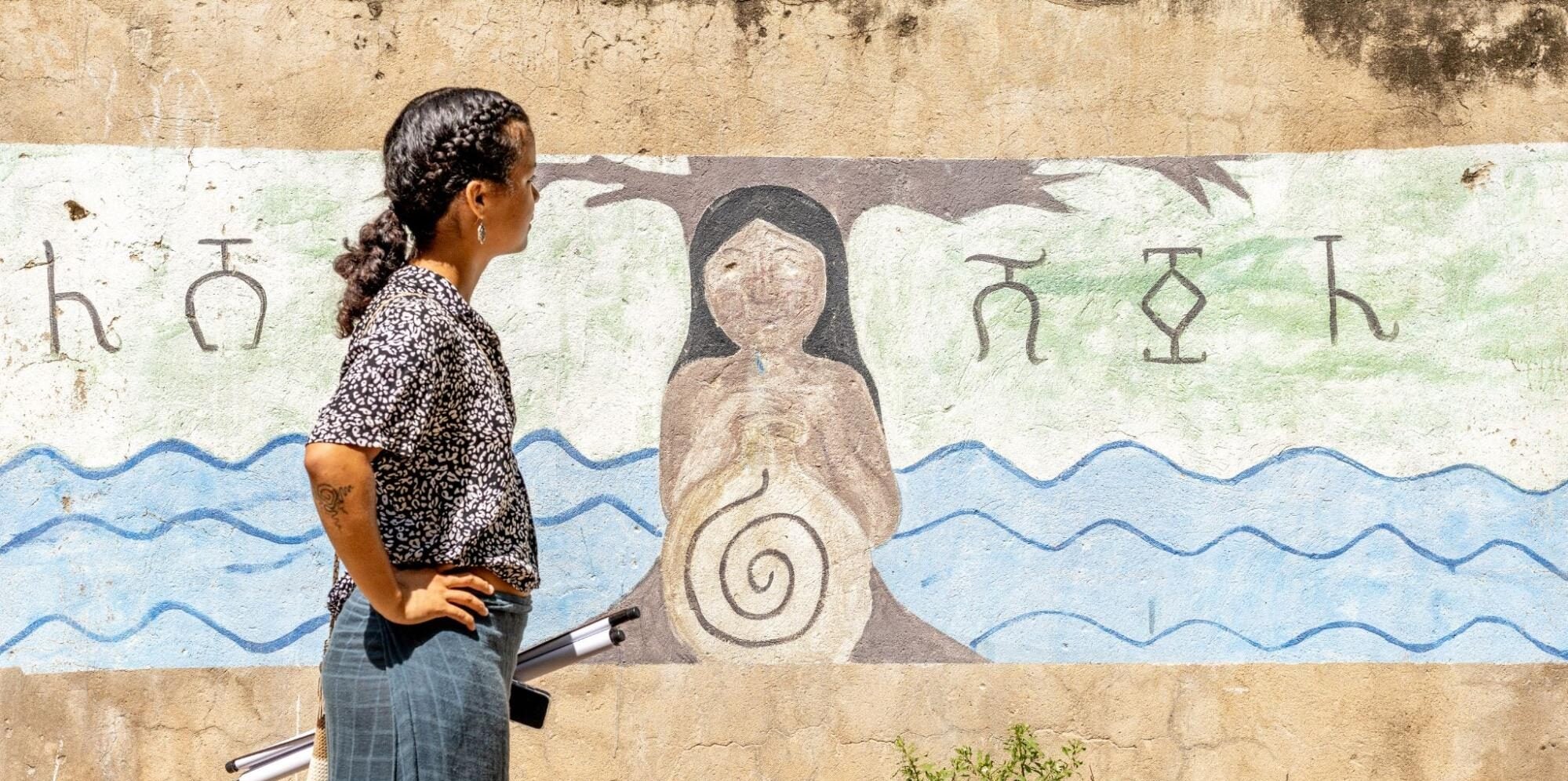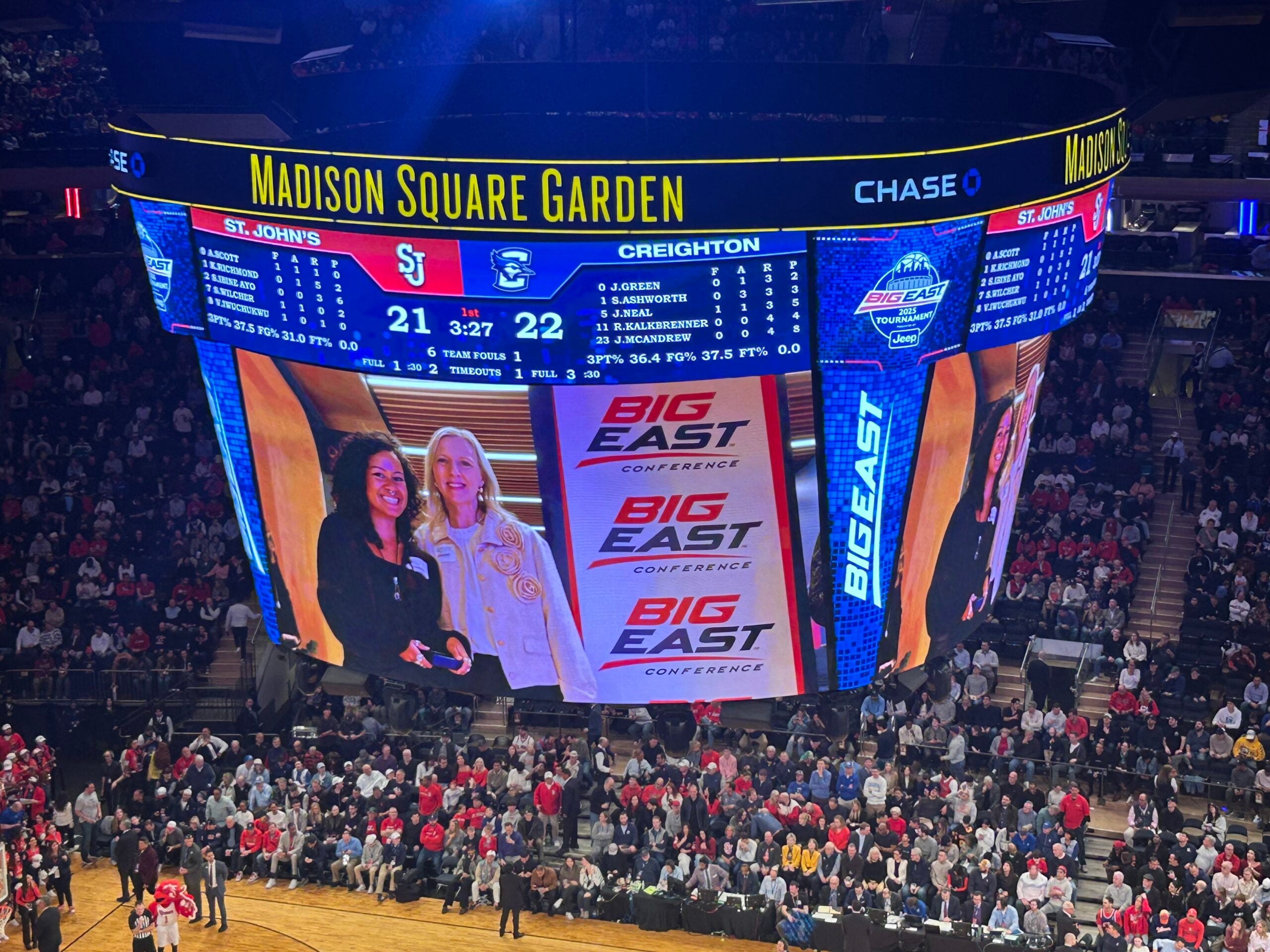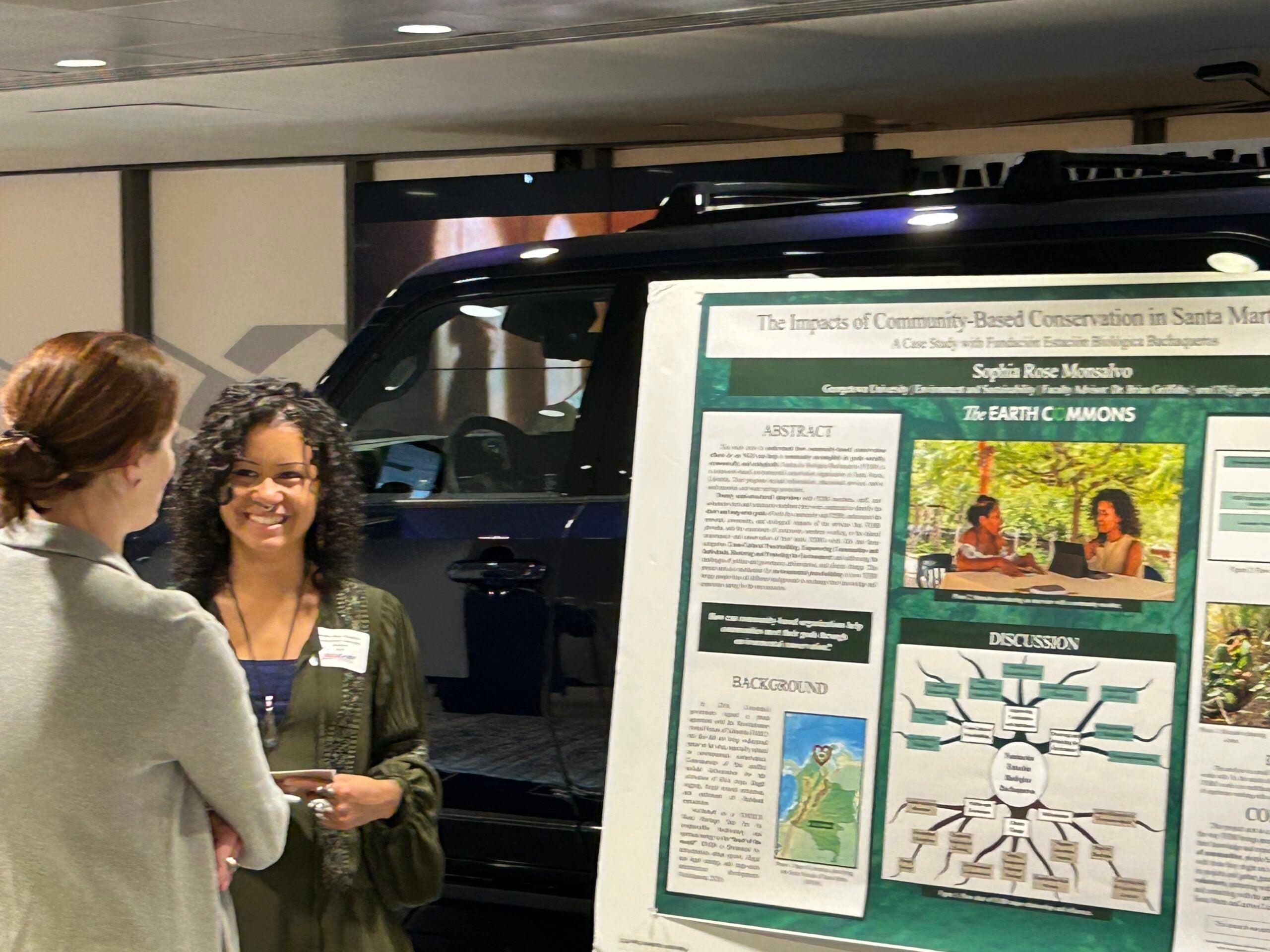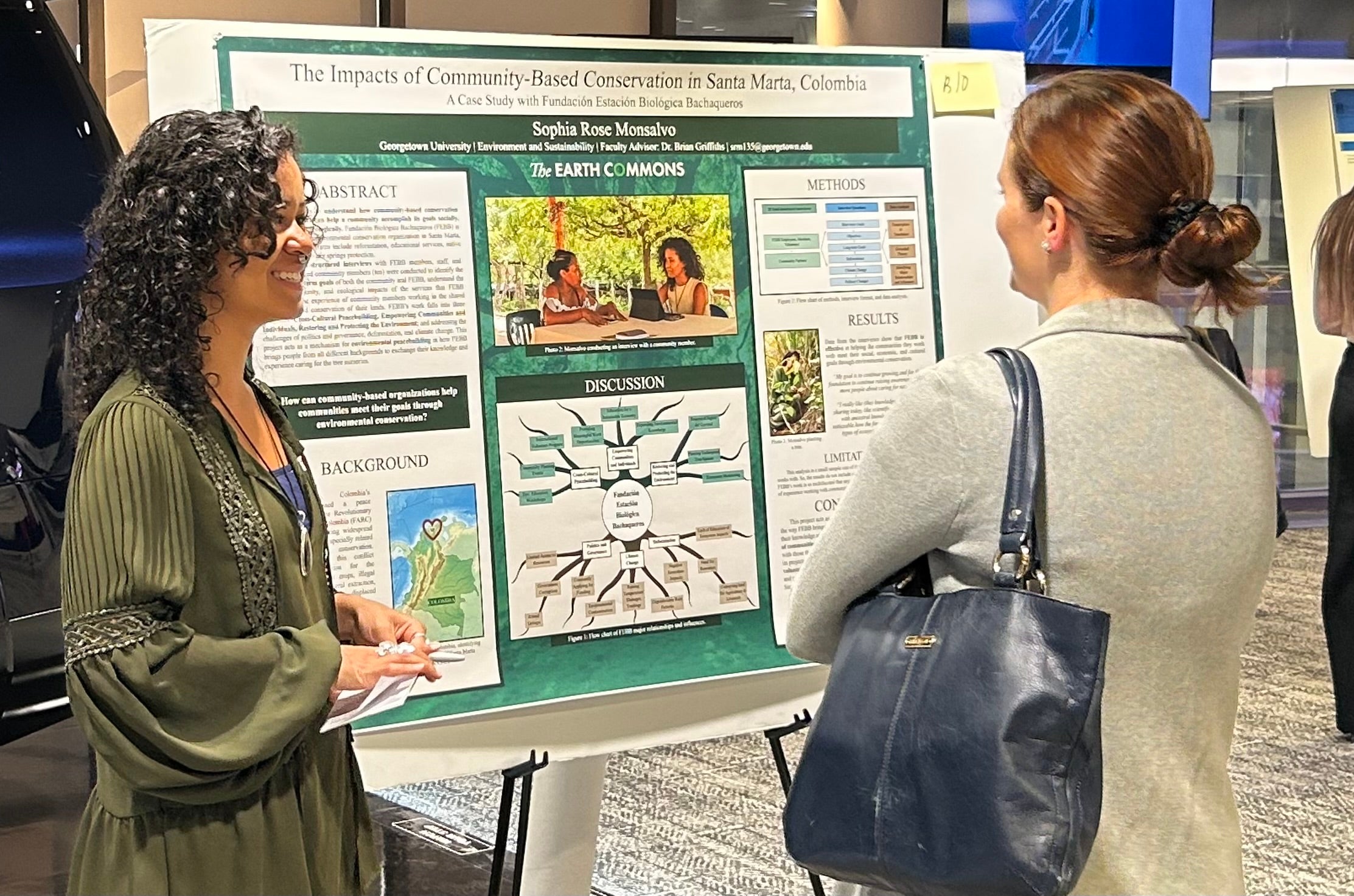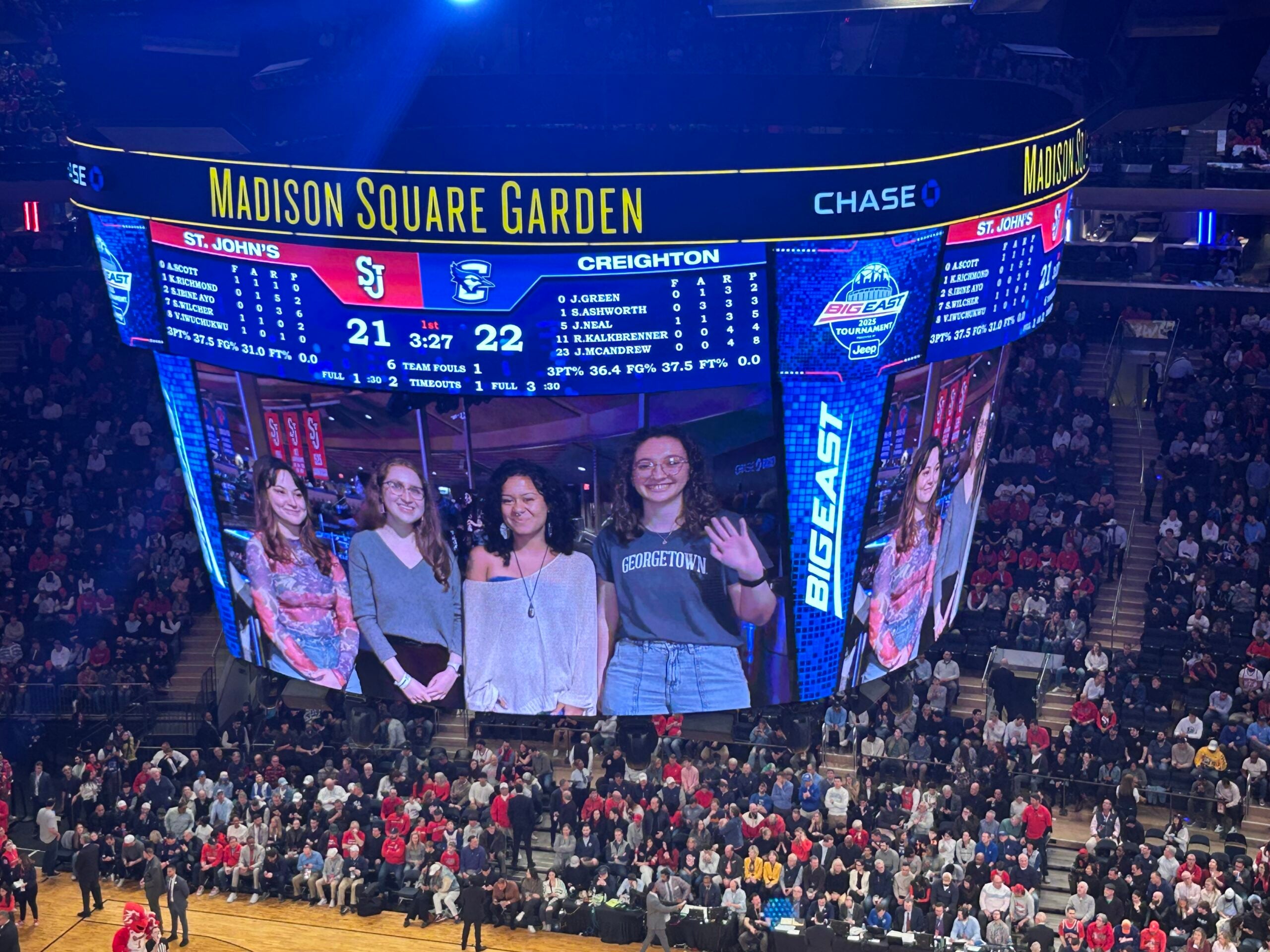I saw how people worked to heal themselves, their communities, and the ecosystems around them by choosing to plant life, mending the scars of loss and destruction.
Sophia Rose Monsalvo
The Impacts of Community-based Conservation in Santa Marta, Colombia: A Case Study with Fundación Estación Biológica Bachaqueros
Sophia Rose Monsalvo (C’26) is part of the inaugural class earning the B.S. in Environment & Sustainability. Her recent research in the Sierra Nevada de Santa Marta in Colombia, where she evaluated the impact of environmental and community-based programs, recently won second place at the Big East Undergraduate Research Poster Symposium held in Madison Square Garden.
In the summer of 2024, I visited the Sierra Nevada of Santa Marta to conduct a participatory research project with a community-based organization, Fundación Estación Biológica Bachaqueros (FEBB). I went to learn about how community-based organizations can help local communities meet their goals through conservation. What I found was something even greater. I saw how people worked to heal themselves, their communities, and the ecosystems around them by choosing to plant life, mending the scars of loss and destruction.
The Setting
FEBB was established in 1993 in Santa Marta, Colombia. They focus on conserving the region’s most threatened ecosystem, the mostly privately owned tropical dry forests, through technical assistance, capacity building, and environmental investigative services to the community. Their programs include reforestation, educational services, native seed nurseries, and water springs protection. One of the primary features of their work is their management of an 3-hectare natural reserve in the lower foothills of the Sierra Nevada, the Reserva Natural el Jaguar del Carrizal (RJC).
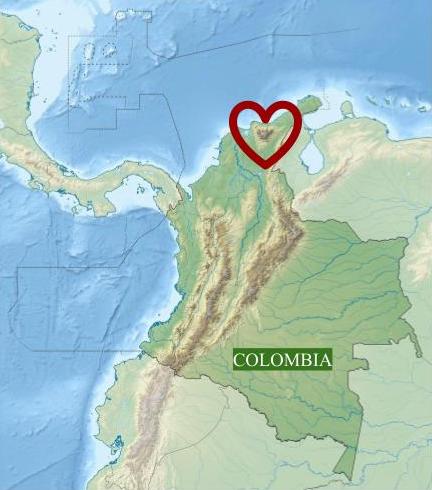
Map of Colombia, identifying the Sierra Nevada of Santa Marta.
The Sierra Nevada of Santa Marta is an isolated mountain range on the northern Caribbean coast of Colombia. Acclaimed for its irreplaceable biodiversity and spiritual energy as the “heart of the world,” the Sierra is threatened by deforestation, urban sprawl, illegal and legal mining, and large-scale infrastructure developments. Climate change has caused the Sierra to experience a temperature increase of between 0.3° and 0.5 °C per decade. There is a desperate need to implement community-based environmental programs for sustainability and organic agriculture in the region to protect the biodiversity of this vulnerable, irreplaceable ecosystem and the people who depend on it, including several indigenous groups whose ancestral lands are threatened by environmental degradation, land grabbing, and resource extraction.
In 2016, Colombia’s government signed a peace agreement with the Revolutionary Armed Forces of Colombia (FARC), but this did not bring widespread peace in the area, especially related to environmental conservation. The conflict between FARC and Colombia lasted over five decades and created widespread fear, internally displaced communities, and spread violence throughout the country. Consequences of this conflict include deforestation for the cultivation of illicit crops, illegal logging, illegal mineral extraction, and settlement of displaced populations. The cultivation of coca crops dominated lands and left detrimental impacts on ecosystems, the majority in indigenous and Afro-Colombian communities.
These factors set the stage for the work of FEBB to bring communities together across boundaries, heal relationships, and restore the native ecosystem.
End of carousel collection.
The results are in: Monsalvo garners top 3 win
Monsalvo earned second place win at the Big East Conference Research Symposium, where she presented her work on conservation efforts in Colombia! Georgetown students swept the competition at Madison Square Garden, winning the top three prizes.
Read the storyMethods
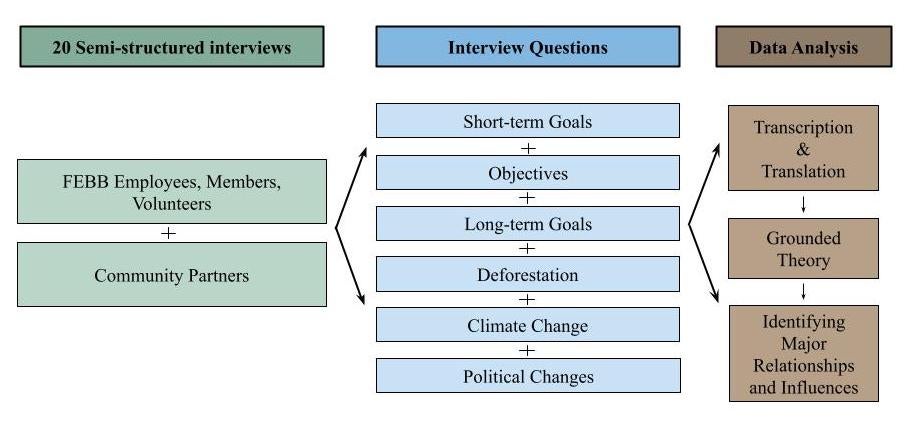
Flow chart of methods, interview format, and data analysis.
Discussion
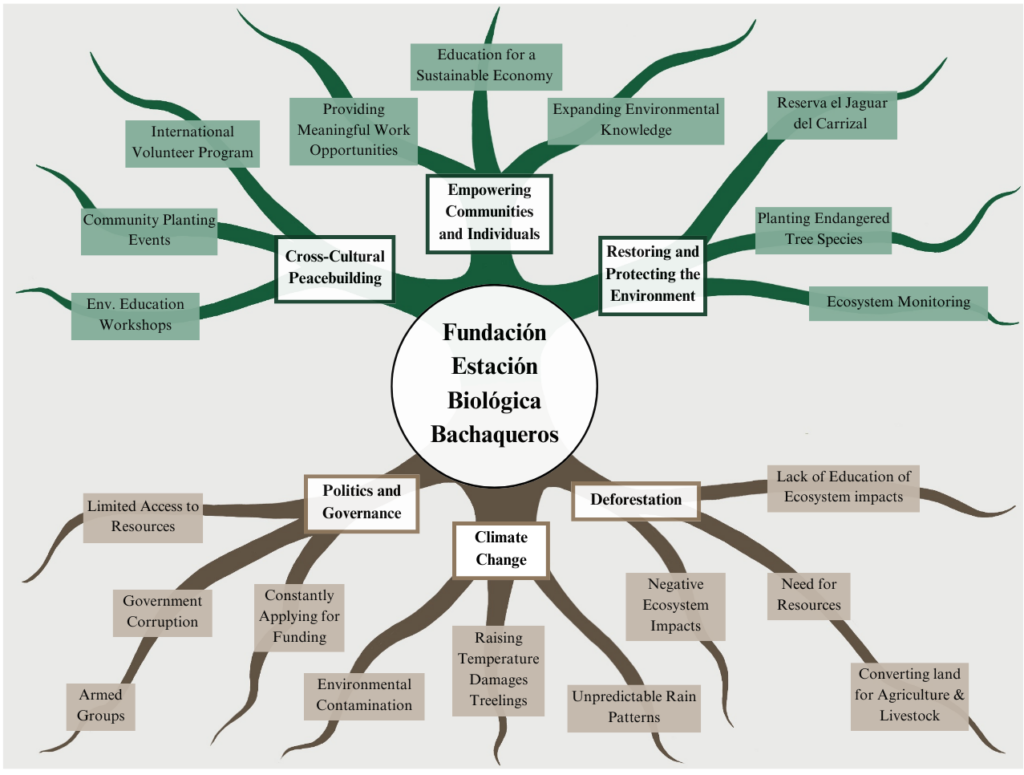
Flow chart of FEBB major relationships and influences.
I conducted interviews with FEBB staff, members, and volunteers while volunteering at the RJC and visiting local communities that were part of the Viveros Hermanos Nursery network. It became clear that FEBB’s programs work to meet the needs of communities while emphasizing environmental conservation. I established that FEBB’s work falls into three categories: Cross-Cultural Peacebuilding, Empowering Communities and Individuals, and Restoring and Protecting the Environment. Their relationship-building work addresses three central challenges: Politics and Governance, Deforestation, and Climate Change.
Cross-Cultural Peacebuilding
Monsalvo observing a mural at the Wayuu reserve in La Guajira.
My analysis determined that FEBB effectively creates the space for cross-cultural relationship building at their community planting events at RJC and their environmental education workshops hosted in the city of Santa Marta. Participants also noted that one of the greatest strengths of this program is the ability to exchange knowledge with people whom, without Viveros Hermanos—or Sister Nurseries, a regional reforestation project that supports communities to create nurseries for the endangered trees native to each ecosystem—they would not have met. FEBB organizes community planting parties, posts them on social media, and invites people from the city to stay at the reserve and plant trees for the weekend. During their day-long environmental educational seminars, not only do people share their experience of creating their nurseries, but they also share a meal and connect about their lives.
My goal is to continue growing and for the foundation to continue raising awareness among more people about caring for nature.
International volunteer at RJC
Contrary to environmental conservation in the West, FEBB includes and relies on the cultural and spiritual understandings of the indigenous communities of Santa Marta to plant trees and care for the environment. They are a central part of the exchange of knowledge that occurs throughout their lives by sharing the knowledge of the Sierra that has existed in their communities for time immemorial.
I really like (the) knowledge that they are sharing today, like scientific knowledge mixed with ancestral knowledge, and it is very noticeable how the foundation works with many types of ecosystems and communities.
First-time visitor to a FEBB workshop
This relationship-building work combats the decades of community separation, terror, and mistrust that were brought on by the violence. Initiatives like Viveros Hermanos give people the space and community to counteract the destruction that has come to their lives and foster hope and love for a better future and healthier environment. Though the foundation has to maneuver limited resources and constant applications for funding as a nonprofit, its strength in community building reduces its reliance on political structures for support.
Receiving the training, the importance of the forest, that already changed (the community’s) opinion on the forest a little, so it is very fundamental to work with the organization because we are going to start working with other communities.
Campesino community leader
Restoring and Protecting Native Ecosystems
Treelings at the Reserva Natural el Jaguar del Carrizal (RJC). Photo: Sophia Rose Monsalvo
The goal of environmental conservation is precisely what brings FEBB and these communities together. Viveros Hermanos has planted hundreds of thousands of native endangered tree species, and they are working towards a goal of one million trees planted. Their work reforesting the RJC has transformed the ecosystem. In a recent study done with a local university, they were able to identify and catalog hundreds of birds that inhabit their reserve. Reserva Biológica El Jaguar del Carrizal is actively protecting flora and fauna by protecting land where these species can thrive. As a result, communities noted that they have seen visible changes in their ecosystems through their participation in Viveros Hermanos.
The foundation has always been supporting environmental education issues in schools because they have gone to schools, they have brought together communities, schools, so that they can participate in the nurseries, in the Viveros Hermanos project, and can allocate some areas for conservation and reforestation.
13-year FEBB member
This project is so interesting and unique in balancing those human needs and environmental preservation.
International volunteer at the Reserva Natural el Jaguar del Carrizal
Climate change is a critical factor in this work: rising temperatures and unpredictable rain patterns have made it more difficult to plant trees. Variations in rainfall have made consistent planting difficult because planted trees can die if rain does not come for days at a time. Communities noted that climate change is impacting everyone. The challenge is growing over time: efforts to reforest can reduce temperatures and shield local ecosystems, but the sustained rising temperatures and shifting weather patterns brought by climate change make efforts to reforest more difficult.
We want to generate, in the longer term, broader community restoration processes in the Sierra Nevada de Santa Marta to restore our different ecosystems and yagura forests and springs that previously existed in various parts of the mountain range, so that more water grows, so that there are more trees, so that it rains better so that people live more happily.
FEBB staff leader
Empowering People and Communities
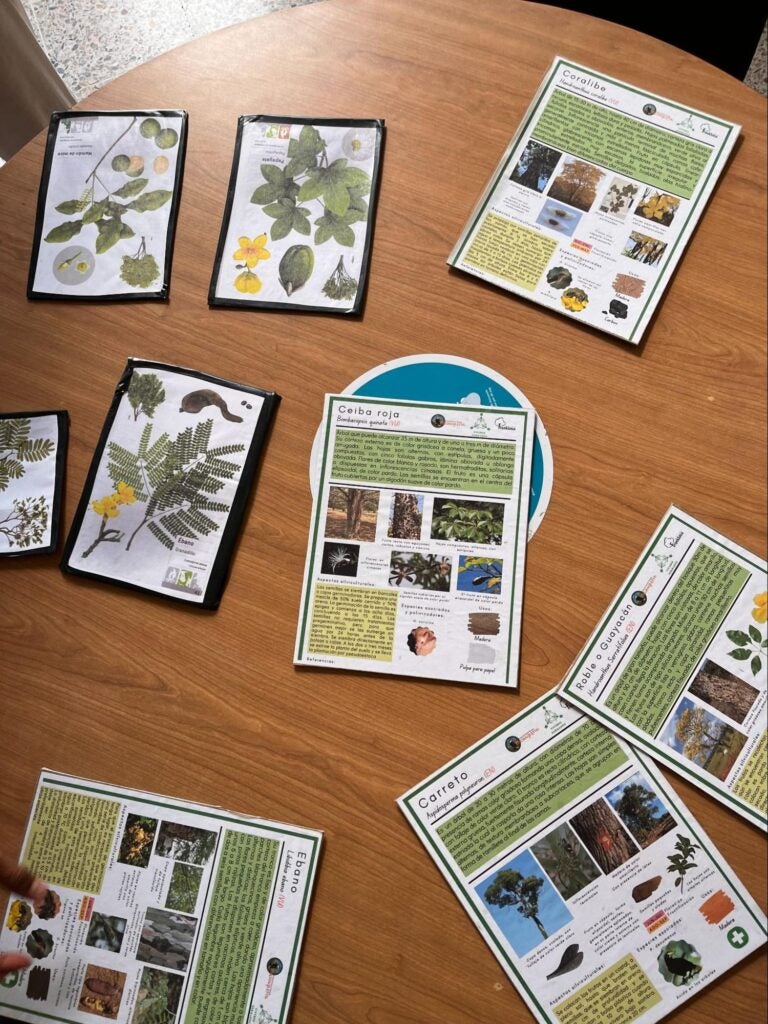
Education materials from one of FEBB’s workshops highlighting the various endangered tree species of the region.
FEBB empowers people and communities through education, work opportunities, and environmental knowledge. They provide meaningful opportunities for community members to be employed and contribute to a project that is making a difference in their backyards. Volunteers can contribute to a project that is meaningful and gives their experience greater purpose than just tourism. They work to increase public consciousness about environmental systems, sharing topics like the best way to collect seeds, ways to identify different forest relics, and the variety and importance of the ecosystems of Santa Marta and beyond. They also introduce techniques like agroforestry, which integrate the cultivation of agricultural products like cacao underneath the shade cover of forests. Participants of the program can also learn about the importance of trees that are integral to the ecosystem but often overlooked because they do not produce fruit. Expanding awareness about these trees helps to shape people’s support for native trees in their community and fosters ecological belonging.
The foundation is always working for the care and ecological restoration of the ecosystems of Colombia, with this emphasis and with this very important characteristic of always working with the communities… although our main emphasis is on the environment, but also how do we understand the environment without the human being, who is an animal that is part of it.
Director of the the Reserva Natural el Jaguar del Carrizal
Members of the FEBB staff would joke that deforestation is good for the foundation because it gives them more work to do. Deforestation in Colombia is a social issue. FEBB creates an alternative to deforestation by presenting communities with the knowledge and resources to make environmentally friendly products like wine and feed for animals. They also help communities reduce the trash and contamination in their environment by repurposing waste for other uses. They are directly addressing the needs of the communities and showing people how they can generate a sustainable income that also protects their community.
The foundation is always showing us ways of what to do with that waste like glass (and) plastic so that we give it a second chance and it does not become an environmental pollutant. There were also workshops where they taught us how to make food for farm animals with foliage from the same forest, to take advantage of all that green that the forest gives us so we can provide food and lower the cost of food for our farm animals.
Workshop participant
What’s next
FEBB’s programs establish relationships between people and communities that otherwise may never have begun. That’s why I have decided to continue my collaboration with FEBB and return this upcoming 2025 summer. I plan to create an interactive travelers’ guide and educational curriculum to increase local—and even international—awareness for and engagement with FEBB’s work. The key takeaway of the curriculum and guide will be to emphasize the importance of protecting the Sierra Nevada of Santa Marta, the heart of our world. I hope this guide leads to broader engagement with FEBB and brings more community members and international volunteers to the project and the Sierra Nevada of Santa Marta.

